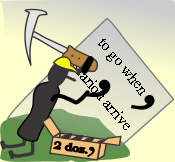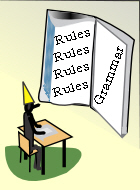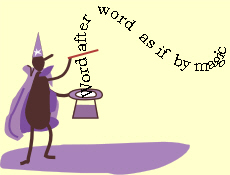|
Number 76 — March 17, 2006
Peeking At Pronouns — Part 4
· Previous · INDEX · Next ·
Bearing in mind the simple definition of the antecedent of a pronoun, I come to the most common errors in pronoun use.
1. CONFUSED IDENTITY:
In my editing work, I sometimes find two nouns preceding a pronoun in the same sentence that result in confusion. For example:
Men prefer books by male authors. They have been polled several times.
Does this mean men or male authors are the subjects of the polls? You recognize this error by inserting the subject referenced by the pronoun, which yields:
Men prefer books by male authors. (Men / male authors?) have been polled several times.
Now edit your sentence to remove the ambiguity. One solution might be:
Several polls suggest men prefer books by male authors.
This yields the best possible solution; the pronoun went away, taking the confusion with it.
2. MULTIPLE ANTECEDENTS:
The rules for multiple antecedents:
Rule 1: Use a plural pronoun if the antecedents, whether individually singular or plural, are joined by and, making them a compound subject.
Rule 2: If or or nor unite alternate subjects, make the pronoun agree with the antecedent closer to it.
Here are some examples:
Rule 1: Both writer and agent said they agreed. (Compound subject; both parts singular = plural pronoun.)
Rule 1: Both writers and the agent said they agreed. (Compound subject; one part plural and one singular = plural pronoun.)
Rule 2: Neither the writers nor the agent said he agreed. (Alternate subjects: first plural and second singular = singular pronoun.)
Rule 2: Neither the writer nor the agents said they agreed. (Alternate subjects: first singular and second plural = plural pronoun.)
3. INTERRUPTING PHRASE:
In the following sentences, what will dry and crumble?
Store tobacco in a jar with a slice of apple. The jar should be tightly sealed. Exposure to dry air causes it to dry and crumble.
Obviously, the author cares about the tobacco, but the jar has intervened between the intended antecedent and the pronoun. This is a case where the author knew the intent, but went too fast and did not edit with care; a common case.
4. RECOGNIZING THE REAL SUBJECT:
Test your grammatical knowledge by identifying the subject of this sentence:
The use of gloves when gardening is recommended. They protect against blisters.
The subject is 'the use of' which is singular. While the intent of the plural pronoun is to reference gloves, they are not the antecedent of the pronoun. The obvious editing correction:
Gardeners should wear gloves to protect against blisters.
Again, I eliminated the pronoun. (This might be a good time to review articles 53 through 56 on Concise Writing, which would avoid this type of problem in the first place.)
5. GENDER:
Modern English lacks a pronoun that includes both genders. Presumably English ignored gender bias in the beginning because Man meant all humans, and therefore invoked the pronoun he to refer to both sexes. Modern speech overcomes the difficulty partly by using they as a singular pronoun. For instance, I might say; If a reader doesn't like my proposal, they can ignore it. In formal writing, such a misuse is not acceptable. The problem is further compounded by indefinite pronouns—everybody; everyone; nobody; anybody; somebody; someone; and probably a few more I can't think of—that have plural meanings with singular classifications. In grade school, my teacher taught me to write; everybody must bring his lunch. But half my class members were girls. The solution falls to the ingenuity of the writer. The lunch question might be solved with; each boy and girl must bring a lunch. Whatever solution you choose, try to avoid expressions using he/she or him/her. If you must resort to these terms, use them sparingly.
6. CONFUSED IDENTITY:
This case calls for consistency. Here are the rules:
Rule 3: A collective noun treated as singular takes a singular pronoun.
Rule 4: A collective noun treated as plural takes a plural pronoun.
Here are examples:
Rule 3: The team was disgusted by their play in the tournament. (was disgusted = singular verb: The pronoun should be singular = its.)
Rule 4: The student body aren't pleased, but it supported the coach. (aren't pleased = plural verb: The pronoun should be plural = they.)
7. NUMBER AND PERSON:
Few errors occur in number and person, but occasionally along come convoluted sentences—usually they are long—where subjects are plural and pronouns singular, or female subjects get labeled with a male pronoun. These mistakes are carelessness and the author knows better.
8. GRANNY'S RULE:
Our grandmothers told us an ounce of prevention is worth a pound of cure. Twice in this article, I suggested a corrective measure is "to make the pronoun go away." More efficient is not to write sentences in the first place in which you do not understand the grammatical parts. The four great sins in writing are redundancy, verbosity, tautology and ambiguity. Find ways of avoiding them and you will not have pronoun problems. If choosing who or whom, he or she, that or which, or similar pronoun alternates perplexes you, recast your sentences to make the problems go away. In 99 cases out of 100, your writing will be more concise thereby avoiding the four great sins.
· Previous · INDEX · Next ·
| 

